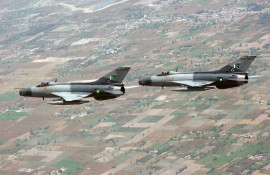
The defeated tribes fled, so Alexander learnt in Ora, to the rock of Aornos. Word had already reached Alexander about the impending approach of King Abisares of Kashmir at the head of a large army, to marry up with the Pakhtuns in a bid to defeat the invaders. Fearing that the united force sweeping down the forested slopes east of Ora would be a match hard to suppress, Alexander hurried to destroy the fugitives on Aornos.
Of Aornos, the Greek historian Arrian, writing three and a half centuries after Alexander tells us: “The circumference of Aornos is said to be about 25 miles and its height, not including the peaks, nearly 8,000 feet”.
From Megasthenes, the Greek ambassador to the court of Chandragupta Maurya, we know that the base of Aornos was washed by the Sindhu River. There have been contenders for Aornos. The peak of Ilam just south of Mingora in Swat is one. While Ilam fits Arrian’s description, it is far from the Sindhu — or any other river. The hill of Ranighat in Buner is another. While this is a little ways off the Sindhu, it does not have arable land.
Studying the geography of Alexander’s conquest of Bazira and Ora, we have to agree with Aurel Stein’s conclusion that the only hill that can fit the picture of Aornos is Una Sar. Sitting in the great crook where the Sindhu makes an eastward arc and overlooking Chakesar to the southwest and Besham to the north, Una Sar is 8,587 feet high with the river flowing around its three sides.
Now, Una in Pashto is pronounced with the nasal-palatal ‘nr’ that we hear in several languages in Pakistan. Because the westerners could not produce that hard rolling syllable, they simplified it to a simple ‘r’ sound. They dropped the ‘sar’ for they understood it meant ‘peak’.
When Alexander made the top of Aornos, he found that the tribes had taken refuge on a slightly lower adjacent peak that we today call Pir Sar — Saint’s Peak. The area where Alexander was positioned is known as Burimar. Behind his forces was the peak of Una Sar, rising 1,000 feet higher and in front was a saddle about 300 feet lower beyond which, and well out of the range of Alexander’s artillery, was the Pakhtun sanctuary. To attempt storming across the depression was suicidal. Knowing this, even as they waited for Abisares’ reinforcements, the Pakhtuns taunted Alexander from the safety of their haven.
Even today, Una Sar is quite thickly forested with pine. In the 4th century BCE, it would surely have been a veritable forest. And so Alexander ordered every soldier in his army to bring one hundred pine logs, cut and dressed. These were dumped in the depression of Burimar and filled up with soil. By and by, the earthwork extended far enough to permit archers and artillery to bombard the refuge-seekers of Pir Sar.
The Pakhtuns sent an offer to surrender on terms. But their actual plan was to draw out the parleys until nightfall when they would be able to escape under cover of darkness. Then, as now, treason was common and Alexander was informed of the Pakhtun plan. As they removed their pickets in preparation for withdrawal and as day passed into night, Alexander, accompanied by 700 soldiers, attacked the men on Pir Sar.
A great slaughter took place on the hill of Pir Sar, some of whom would surely have been buried on the peak. I believe no saint is buried on the hill, but it is the memory of so many good men giving up their lives for their country that sanctifies the hill.
Published in The Express Tribune, November 6th, 2011.
COMMENTS (12)
Comments are moderated and generally will be posted if they are on-topic and not abusive.
For more information, please see our Comments FAQ

1735196035-0/beyonce-(7)1735196035-0-165x106.webp)









1735025557-0/Untitled-(96)1735025557-0-270x192.webp)







If the ruggedness of their mountains is the main advantage of Pashtuns, why many other people in similar environment couldn't develop such capacity for resistance e.g. Kashmir, Nepal, Chitral, and many other places around the world?
There may be other reasons responsible for this characteristic of Pashtuns i.e., the strategic history of Pashtun areas having faced invasions in history that few other regions in history might have---Imagine mighty armies descending from HinduKush, camping in Pashtun areas, and then looking for supplies(as well as women so such a strong sense of female honour) for soldiers in Pashtun hamlets and villages---the scarcity of resources coupled with hard-terrian suitable for guirella warfare gave Pashtuns motivation as well as reason to fight back---
A wonderful mixture of fact, fancy and fiction. Unless you, Sir, disclose your sources and provide a bibliography, nothing can be verified. Being a professor of history, I am sorry I take your articles with a nod and wink - wink preceding the nod.
@Adeel759, If its a geographic advantig u called it then there are so many others examples in the world there is same envirment exist but peoples dont fight for example switzerland for examlpe hungrian never bothers to take arm against russia.
@Adeel759
Thank you for a very perceptive contribution to the discourse. A refreshing departure from illinformed,uneducated rants.
I have already requested that such articles should be supported by photographs and geographical maps and also showing route of travel of Alexander and his army. References shall also make the articles more authentic and interesting. I shall wait for your next article.
good article but it would be more beneficial to quote your sources so that we can further study them for more information.
As always I look forward to your articles, I do not disagree with your point about the wrongly named pir sar or that Pashtuns have never been defeated. However I disagree with the impression that the people who fought at pir sar were Pashtuns. That is highly unlikely, they were more likely the original inhabitants of Swat .The modern day yusufzai tribes only started migrating from the 13th century onwards .. Most if not all Pashtun tribes started migrating from well after alexanders time to the areas they now inhabit.
Great article sir. i am a history freak and i wait for your articles eagerly. thanks.
@Ali Tanoli. Pashtuns fight for many reasons, one and the most important is the advantage of the ruggedness and forest density of their location, otherwise we know that they were driven out of Kabul by few hundreds of fighters led by dozens of US Spec Ops post 9/11. Keeping the mountainous regions of Pashtuns occupied has its own disadvantages. First of all its hard to fight gurrela war there, since hit, run and hide is extremely good tactic there, and other reason is to keep control of "what"?, occupation of that region is nothing other than wasting your fortune since there is nothing to get out of there, except for the new discoveries of Lithium Reserve in Afghanistan. On The other hand, Punjab constitutes plains,and rich plains. Lands filled with products of the age, and in plains you can only fight to death and victorious would only be the mightier. And occupation of punjab was important because it was fruitful for the occupiers. Thats it, otherwise everyone can fight ......
A great piece of history. Please keep writing on such things.
No one is undefeatable only god is forever make sure this my friend and in english it says indus river not sindhu river and pushtun fight unlike punjab every one came and occupy it.